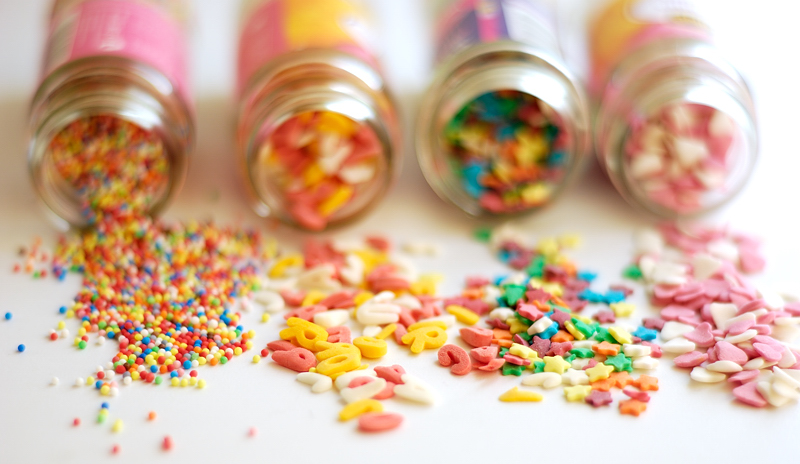Between Halloween and the holidays coming up, we’re in a sugar fest (not to mention midterms powered by sugary energy drinks. But beyond soda and sweets, where else are sugars hiding?
We all know about table sugar, chemically known as sucrose. It’s made up of a glucose molecule (remember back to cellular respiration in bio) and a fructose molecule bound together. Sucrose is also found in brown sugar, powdered sugar, molasses, and maple syrup. It’s sometimes called beet sugar, cane sugar, refined sugar, or cane syrup depending on the form and source. If you count it up, that’s ten names for just one type of sugar. It’s no wonder that sugar can be so sneaky.
There’s also glucose–our bodies’ favorite energy source. Corn syrup has lots of glucose. Two glucose molecules can link up to make maltose (a.k.a., malt sugar), the sugar in beer. There’s also fructose–“fruit sugar.” It’s found in most fruits (with a similar amount of glucose), honey, and high-fructose corn syrup. And that’s just a handful of common names for a few common sugars!
If you look at most processed foods, you’ll find that one or more of these names for sugar shows up. Unlike in fruit and honey, where sugars are naturally occurring, when the ingredients list lists one of these ingredients it means that the food has added sugars.
Added sugars get a bad rap, and for good reason. According to the Mayo Clinic, high levels of added sugars in foods is often tied to low nutritional value (low in vitamins and minerals), high levels of fat (ever made cookies without butter or oil?), and increased triglyceride levels (that’s medical speak for the fat floating around in your blood). And that adds up to added sugars being connected to heart disease, according to the Harvard Health blog.
Of course, there is a little leeway for our added sugar consumption. The American Heart Association recommends that women get 6 or less teaspoons of sugar a day (that’s about 24 grams) and men get no more than 9 teaspoons daily (about 36 grams). A 12-ounce can of Coke has about 40 grams of sugar. That’s about 10 teaspoons or 10 sugar cubes (and definitely over anyone’s daily added sugar allotment). Would you just eat 10 sugar cubes? Didn’t think so.
Even then, there are some natural sugars to be careful about. For instance, fruit juices contain all the sugary sweetness of the fruit (oftentimes, it’s more because several fruits go into producing a serving of juice) without the fiber of the fruit and the nutrients in the peel. While fruit juice isn’t exactly soda, it’s still something to drink sparingly.
But it’s not as bleak as it may look. After all, we have two important tools: ingredients lists and nutrition facts labels. On ingredients lists, look for syrups, sugar, and anything that ends in “-ose” (for the mnemonic lovers: anything that rhymes with gross). And check the Nutrition Facts label to figure out how much sugar a serving contains (also, check the serving size; so many foods have ridiculous serving sizes).

Photo courtesy of Gloria García/flickr.com
How Much Do You Know About Added and Empty Sugar?
Are you a pro at spotting it? Do you know a little? Did you not pay attention before? On the scale of fresh apple (added sugar: zip) to caramel apple (it’s still mostly apple, right?) to apple cupcake, where do you fall on the sugar smarts scale?
Looking for the key?
High fructose corn syrup is about 50% fructose.
A grande caramel frappuccino has the highest sugar content (59 grams in 16 ounces) compared to Red Bull (27 grams in the 8.4 ounces) and orange juice (about 22 grams in 8 ounces).
Ketchup has two sources of added sugars: corn syrup and high fructose corn syrup. It also has tomato concentrate, vinegar, salt, and spices.
Chocolate milk has about twice as much sugar (25 grams) as regular milk (about 12 grams).
A glass of orange juice has about 22 grams of sugar (nearly twice the sugar in an orange and none of the fiber).
The Cheerios have the least sugar (1 gram sugar per cup), then a KIND bar (Almond Coconut, 12 grams), then Lucky Charms (13 grams of sugar per cup), and then the Snickers bar (27 grams per bar).
If you look at Hershey’s Bliss chocolates (those little chocolate squares), they each have about 3.5 grams of sugar but the white chocolate has 4 grams of sugar per square.
Believe it or not, Vitamin Water is more accurately sugar water (30 grams per bottle) and the Krispy Kreme glazed doughnut has 10 grams per doughnut.


